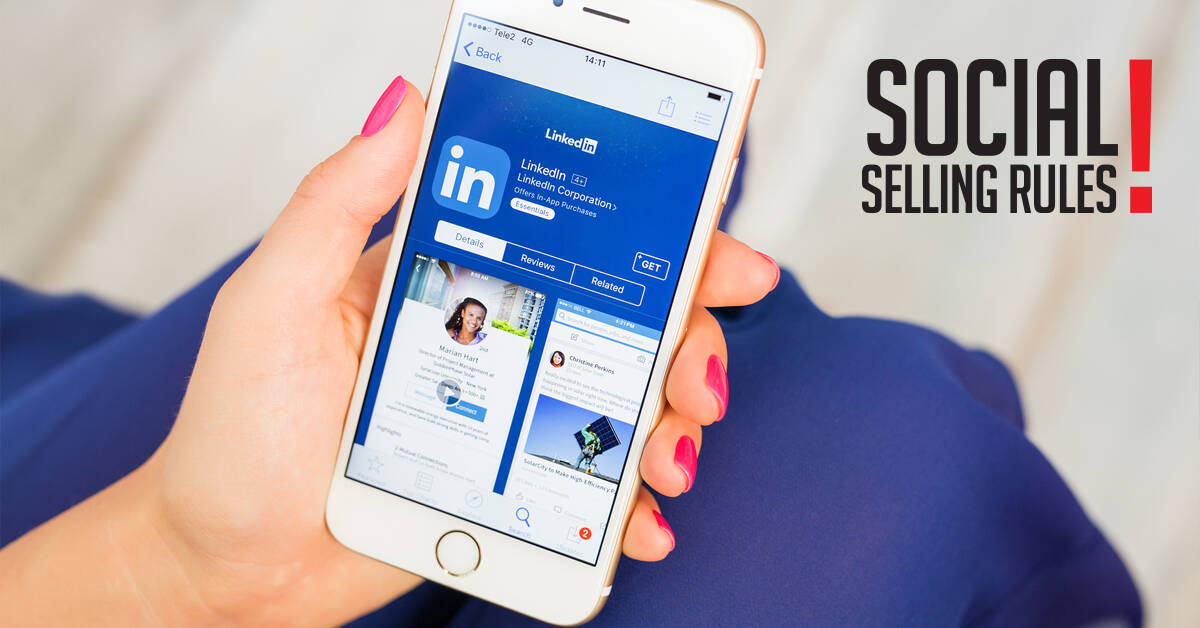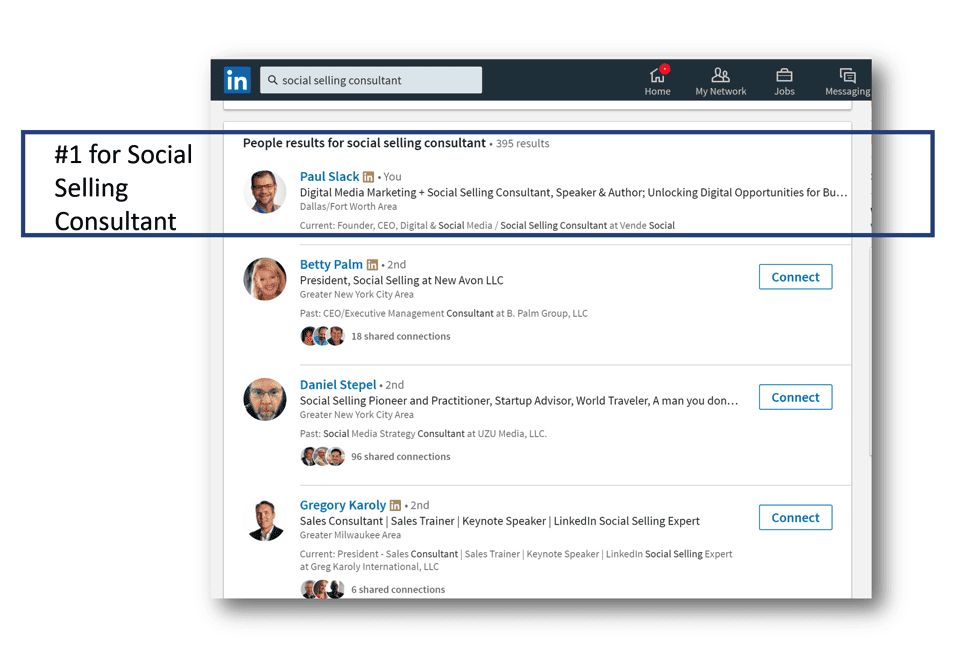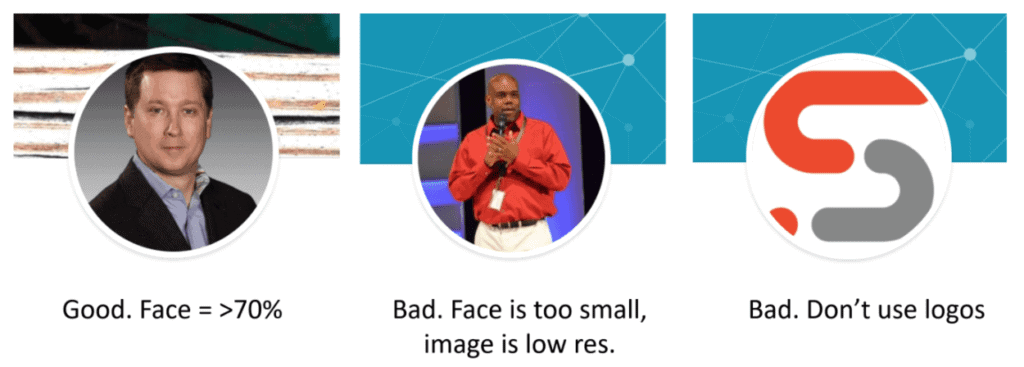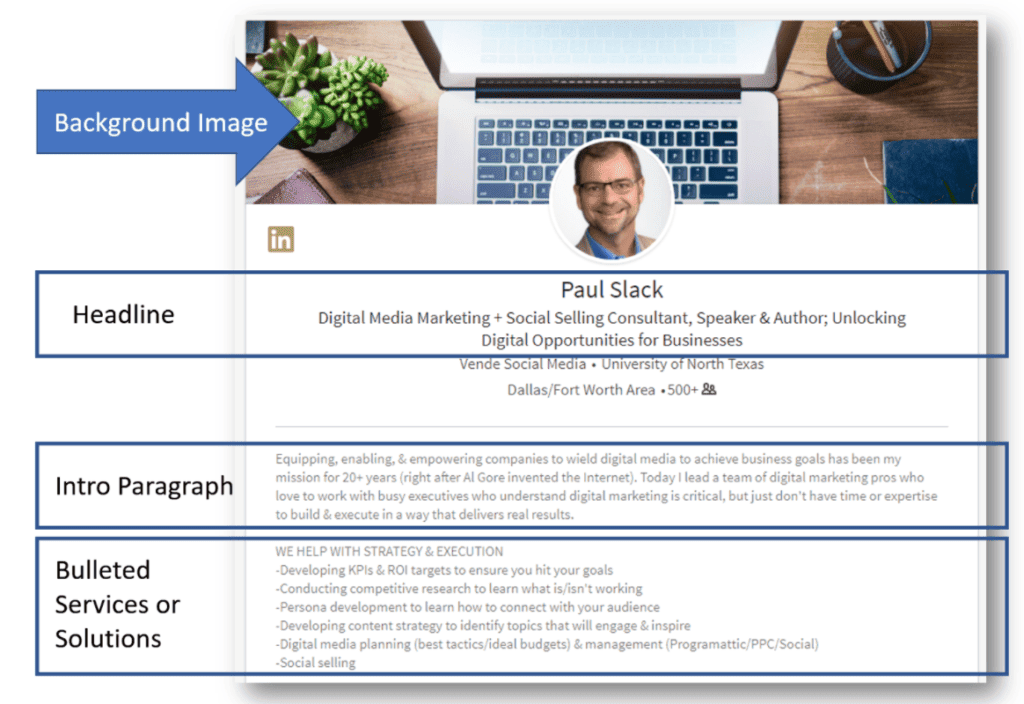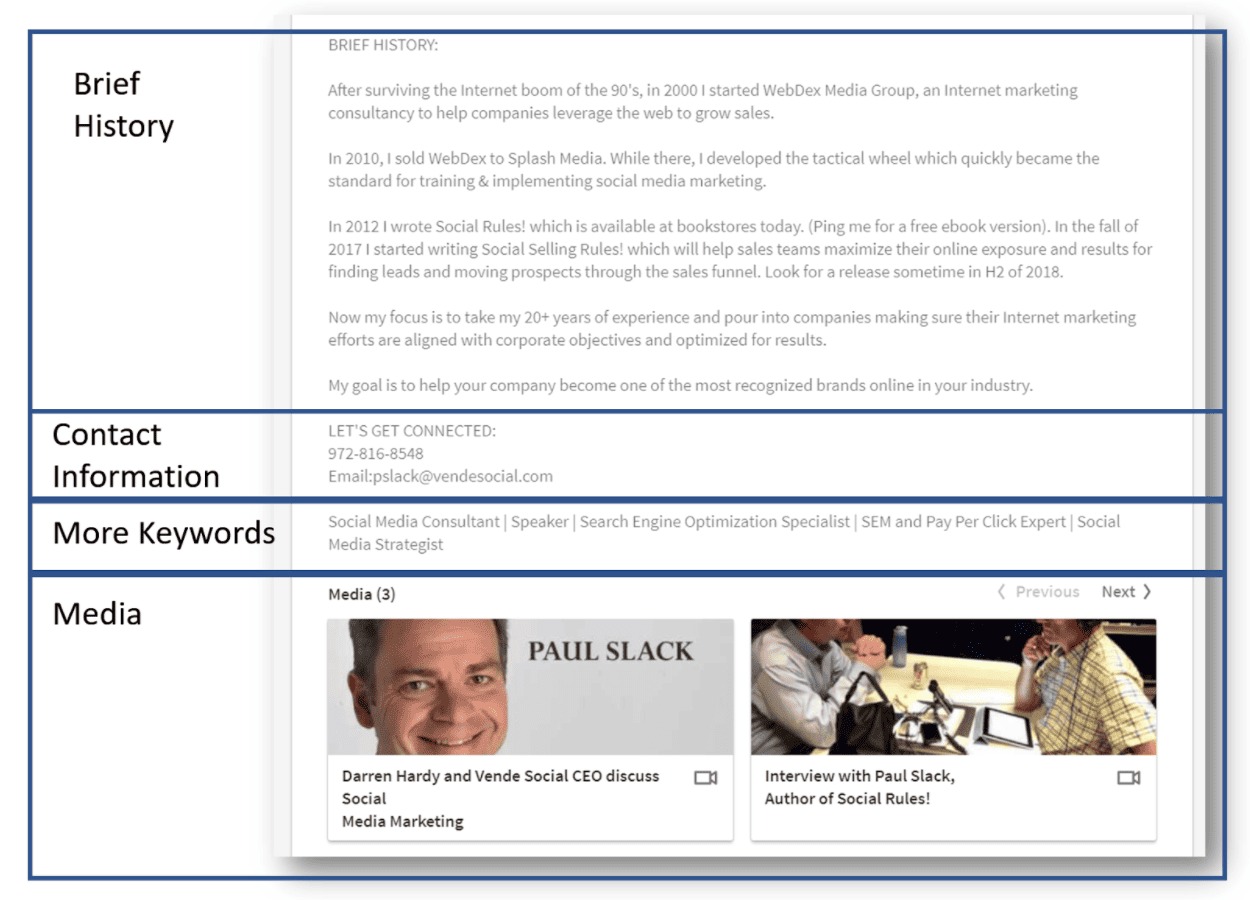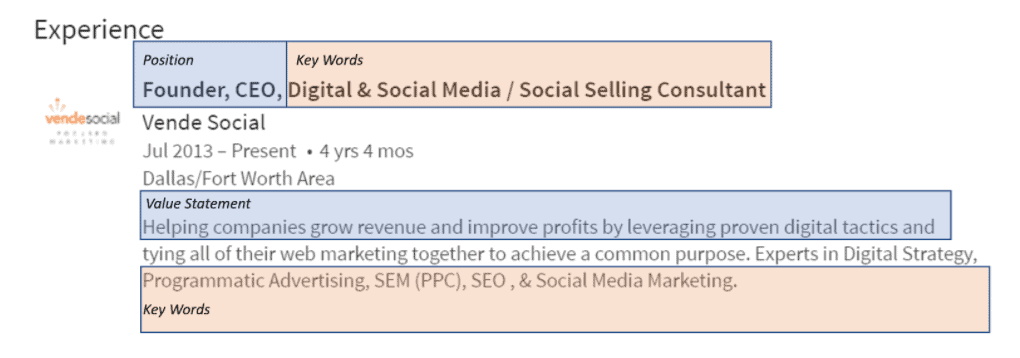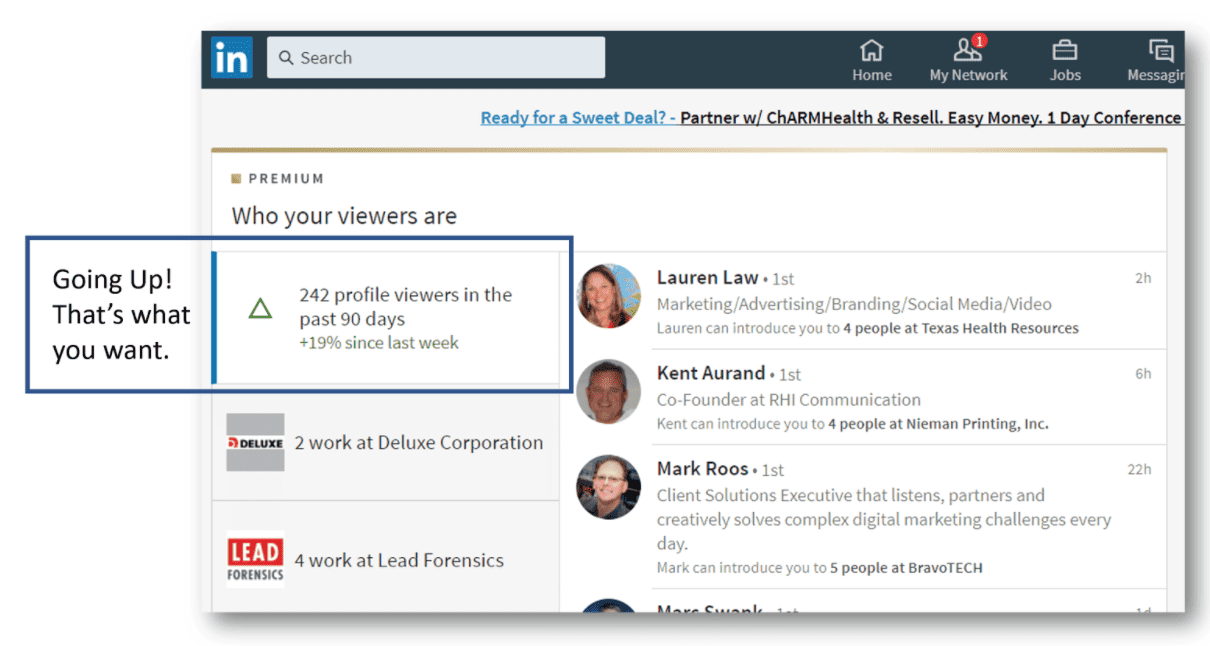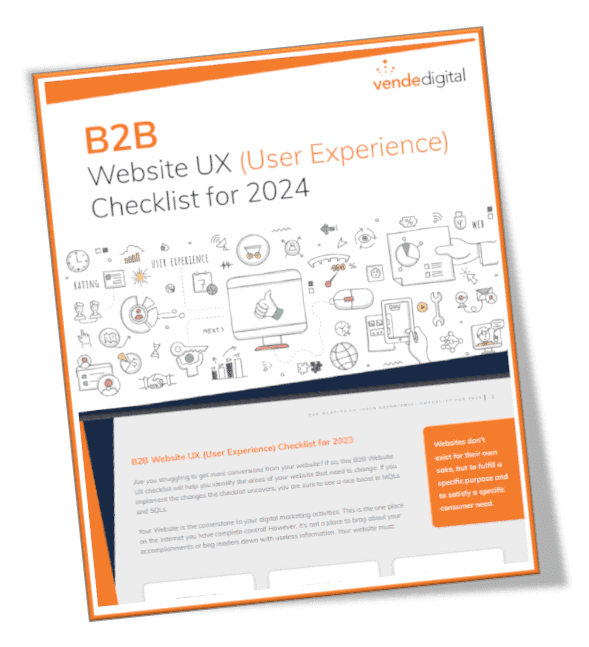This post on tips to makeover your LinkedIn profile is in direct response to a question we get asked all the time by sales and marketing professionals. People want tips on achieving that perfect balance between highlighting the benefits of working with them without coming across as a pushy used car salesman (no offense to any used car salesmen reading this article).
Trust me, there is a right and wrong way to position yourself on LinkedIn.
Wait a minute. Isn’t my LinkedIn profile just an online resume to find my next job?
If that’s what’s running through your head right now, this blog isn’t for you. Turning your profile into an online resume will only prevent you succeeding in your career, not aid you. Here’s why: Your competition (the other sales folks in the universe) are starting to see how leveraging LinkedIn to meet new people, and build a pipeline of prospects and influencers, is more effective and efficient than cold calls and 7 a.m. networking groups. To be successful, your LinkedIn profile must be the central hub for how you help others accomplish their goals, which is a totally different approach than what most sales folks’ profiles look like today. Mentioning the fact that you have been 100 percent of quota and gon on of 10 super-performer trips in the last 15 years doesn’t cut it anymore (not that it ever did). The paradox is that by using LinkedIn to meet, connect, and serve others (social selling), you won’t need to worry about getting job opportunities. They will find you.
How will my LinkedIn profile help me succeed and make my quota?
There are two primary ways LinkedIn can help you make your quota:
- Being found by prospective clients: If you follow these tips and the steps outlined below, you will start showing up in searches by prospects looking for help. Type in some key phrases in the LinkedIn search box that you would like to be found for (e.g., life insurance agent, social media consultant, WordPress website design, etc.). This is where you need to be.
2. Proving you are worthy of their business: People do business with people they know, like, and trust. Having an optimized profile will validate that you and your company are qualified to solve their problem or help them take their business to the next level.
Prerequisites before you jump in:
The following process will help you think through the items you will want to highlight in your optimized profile. You might want to start a Word document or Google Doc to gather this information for future use.
- Know yourself. Are you a Guide – someone who helps navigate the nuances of your industry, company, products/services to help the customer get the best deal for their business? Or are you more like a Sage – someone who has lots of experience and can connect dots and bring solutions based on your industry or vertical experience? What are some common-ground items you might want to highlight in your profile (college fraternity/sorority, background, hobbies, volunteering, etc.)?
- Online Presence Evaluation. How do you look online? Ask yourself, “Based on what I see here, would I want to do business with me?” You need to make sure you are coming across as trustworthy and likable. Are there areas of your career (case studies, associations, committees, etc.), or personal life (charity or community work) you can highlight that will make you stand out?
- Know your business. What is your company’s Unique Selling Proposition (USP)? Start reviewing and gathering company resources (videos, case studies, blog posts, PowerPoint slides) that validate the value you and your company can deliver. Use these to develop key talking points in your bio and as resources to link to (more on this later).
- Know your customer. What keeps them awake at night? What are their most common obstacles? This will help you communicate how you help companies and individuals move away from pain and into results. What would their world look like if they were working with your company?
- What buyers are looking for. Buyers are looking for individuals who know their business/industry, are able to deliver fresh ideas/alternative solutions, willing to work to find/evaluate the best solutions, and can help validate/reinforce their existing thinking. Do you do these things? If so, incorporate how you do them into your bio.
- Competitive Research. Study profiles that show up at the top when you search using keywords. Notice where those keywords are showing up in profiles. Take note of what comes across as impressive and what comes across as cheesy.
LinkedIn Profile Optimization Steps:
Utilizing the following template will help you build a kick-butt, highly optimized LinkedIn Profile. However, I want you to actually write 2-3 versions. Plan on swapping them out during the course of the year. Set an appointment with yourself in 3-4 months as a reminder to swap out your profile. This will keep your profile fresh and your name top of mind.
- Upload a professional looking LinkedIn profile picture. This is not a time to use a selfie or something shot on a phone or your computer. Get a professional high-resolution headshot (head and shoulders) that makes you look good.
2. Write an attention-grabbing (but not cheesy) headline. There are three goals for your headline:
a. Explain what you do. This is a good place to also work in a vertical segment, specific industry or demographic. For example, “Life Insurance Agent Specializing in the Senior Market.”
b. Incorporate a useful key phrase. Think about how your customer would search for an expert in your field and stay away for jargon. For example, in my industry, I see a lot of people who call themselves a Social Media “expert,” “pro,” or even “maven;” however, no one ever searches for these words. It’s much better to use the words “consultant” or “speaker” because that’s how prospects search in my industry.
c. Communicate the value you deliver. Tell the user about the positive outcomes they can expect from doing business with you. Often I will use “Unlocking Digital Opportunities for Businesses.”
3. Develop a winning bio. Use these steps to develop a bio that sets the stage and communicates the value you can bring to the reader.
a. Formula for writing a solution-oriented bio, not a braggadocio one. You have a lot of room here (1,970 characters or 300-320 words) so take advantage of it.
b. Write in first-person as if you were talking to your prospect face-to-face.
i. Intro paragraph
1. Include benefit + pain opportunity + opportunity
2. Formula: Thanks for taking time to read my bio. I help [type of individuals you work with] who don’t have/need to overcome/breakthrough [pain point] + to accomplish/take [opportunity].
3. Example: Thanks for checking out my bio. I help busy executives who don’t have time to stay up-to-date on the latest digital trends, take their companies from obscurity to one of the most recognized brands online by leveraging proven digital tactics that produce real results.
ii. A bulleted list of solutions and services you offer. LinkedIn doesn’t provide formatting options so you will need to use the “*” key or “-” key to create bullets.
c. Brief History – Communicate how you got here and the lessons have you learned along the way.
d. Contact Information – There is a “formal area” for this in your profile but only those connected to you can see it. So, put your contact information here as well so those that aren’t yet connected can still find your contact information.
e. More Keywords – Use your leftover space to add more key phrases.
f. Add Media: The media section of your bio is a great place to highlight webinar replays that you hosted, videos of you teaching or explaining a concept, business photos, etc.
g. Re-read your bio and tweak – Make sure you are talking more about how you can help than using the word “I.” It is hard to talk about yourself without using the word “I” but after you have written your bio go back and see where you can possibly remove “I”s by reworking the sentence structure. For example, you can change “I like to help businesses win online” to “Helping businesses win online is what gets me out of bed each morning.”
4. Include the best positions: You don’t need to go all the way back to bagging groceries at the corner grocer, so focus only on the positions that are relevant to your current role and expertise.
a. Current Position:
i. Title: Include the title of your role here but work in as many keywords as you can.
ii. Company: Be sure to link in your company from the drop-down box.
iii. Description: This is another opportunity to communicate your company’s USP as well as work in keywords. I like to start the last sentence with a transitional statement that allows me to stack on keywords. Here is a formula to use; “Experts in [This is the transitional statement], keyword, keyword, keyword, and keyword.”
iv. Add Media: The media section is a great place to highlight company webinars, videos, images, white papers, case studies, etc.
b. Other Positions: Include positions that highlight your expertise in your current field or other roles that might help you find common ground. For example, serving on the board of directors for a non-profit or being a den leader in scouts.
5. Adding Education and Volunteer Experience: This section is helpful for connecting with others who might have gone to the same school or have an interest in some of the same types of volunteer work. I just got off the phone today with a prospect and discovered, in her LinkedIn profile, that we both have an interest in serving orphans in Africa. I was able to mention this during our meeting and it was a great way to find common ground.
6. Including Skills: This is a great section where you can highlight your skills but you can also discover how others see you. Keywords are important here, so select skills that you feel you have mastered and make sure they tie back to how someone might search for those skills. Also, try to be specific and not broad.
7. Soliciting Endorsements: Very critical section and a terrific opportunity for your customers to tell the world in their own words how you helped them achieve their goals. The key to success here is to solicit these endorsements directly and to make it incredibly easy. I like to write the recommendation for them so that it can be simply cut and pasted. This also ensures that the recommendation highlights areas that I feel are important for future clients to understand.
8. Highlighting Accomplishments: In this section you can highlight publications, certifications/courses, honors/awards, etc. This is a good place to showcase your expertise and qualifications.
9. Editing contact information: Be sure to include your work email and phone number. You can also include links to important websites and other social connections.
10. Don’t forget the background picture: The image that appears at the top of your profile page is an underused feature can really make your profile stand out. LinkedIn provides stock images for their premium subscribers, however, you can build your own. Do a Google search for “LinkedIn background images” for inspiration.
Measuring Success:
The best way to tell if these changes are having an impact will be when people start reaching out to you to connect, ask questions, or request a meeting.
However, be sure to check your profile views and see if they are going up or down over time.
Social Selling Rules for Building the Perfect LinkedIn Profile:
- Your profile is NOT an online resume
- Talk about the problems you solve not the products you sell
- Be sure to use a professional headshot
- Write in first person
- Use keywords everywhere but especially in your headline
- Showcase your work with case studies and recommendations
- Leverage multimedia
- Ask for recommendations/give recommendations.
- Have three versions of your headline and bio that you swap out throughout the year
- Be sure to turn on “Share Profile Changes” when making these updates
You can use many of these same LinkedIn makeover tips to help optimize and tune your other social profiles. Stay tuned for future posts on other important channels to keep your social selling at the highest levels.
